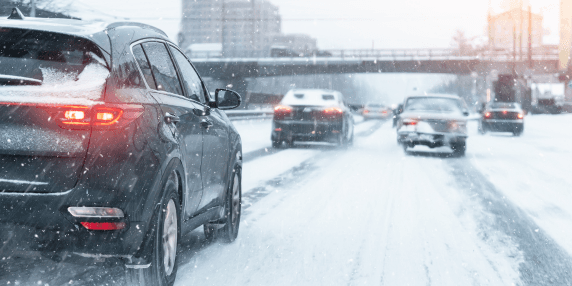Newsroom
ICBC: As snow forecast for South Coast, new survey reveals majority of drivers feel nervous driving in winter conditions
January 30, 2025

With snow finally forecast to arrive on B.C.’s South Coast this weekend, a survey* conducted by Ipsos for ICBC shows the majority of B.C. drivers (60%) feel nervous driving in winter conditions – with more Metro Vancouver drivers (64%) feeling nervous compared to the rest of B.C. (55%).
Yet over one-third (38%) of B.C. drivers surveyed hadn’t installed winter tires on their vehicle for winter when polled in November. More Metro Vancouver drivers had not installed winter tires yet (44%) compared to the rest of the province (31%). The top reasons shared by drivers for not using winter tires were the weather in their area not being severe enough (36%), drivers avoiding snow and icy conditions (27%), planning to put winter tires on later in winter (22%) and the cost of winter tires being too high (19%).
“With snow in the forecast, we’re here to offer guidance and tips to help drivers feel confident and prepared,” said Sarah McKinney, ICBC’s senior manager of stakeholder and community relations. “The key to driving in snowy conditions is to drive slow and steady. Increase your following distance behind other vehicles and avoid sudden movements that could cause your vehicle to skid. Pay close attention as you approach intersections and look for pedestrians.”
Nearly all B.C. drivers (95%) surveyed shared that extreme weather events in recent years have made them more likely to take extra precautions, including checking road and weather conditions before driving (74%), delaying travel until road conditions improve (60%), ensuring vehicle maintenance is done for the change in season (55%), and packing an emergency kit (50%).
More insights from the survey are available in the results summary .
Tips for winter driving:
Prepare your vehicle. Make sure your tires and tread are adequate for the conditions you’ll be driving in. Consider winter tires which provide a lot more grip in snowy and icy conditions. Pack an emergency kit in your vehicle in case you get stuck or stranded. Clear off snow that's built up on your vehicle including headlights, wheel wells and external sensors if you have a collision warning system.
Plan your route and check road conditions and possible road closures on drivebc.ca. In challenging winter conditions, consider delaying your travel until the weather clears or roads are plowed. If you don’t feel confident driving, use public transit, a taxi or ride-hailing service.
Reduce your driving speed, increase your following distance and anticipate turns, stops and lane changes well in advance. If visibility is reduced, turn on your headlights and taillights.
Don't pass snowplows on the road. They may be equipped with a wing blade on either of its sides which may not be visible due to the snow it sprays.
Beware of black ice when temperatures near freezing. If you notice ice build-up on your windshield, there's likely black ice on the road. Black ice is commonly found in shaded areas, bridges, overpasses and intersections. Slow down and increase your following distance in these slippery areas.
*Survey conducted by Ipsos online panel. 628 total surveys completed. Data collected from November 7 to 12, 2024. Those without a valid B.C. driver’s licence and/or have never driven in winter conditions in B.C. were screened out (173).
